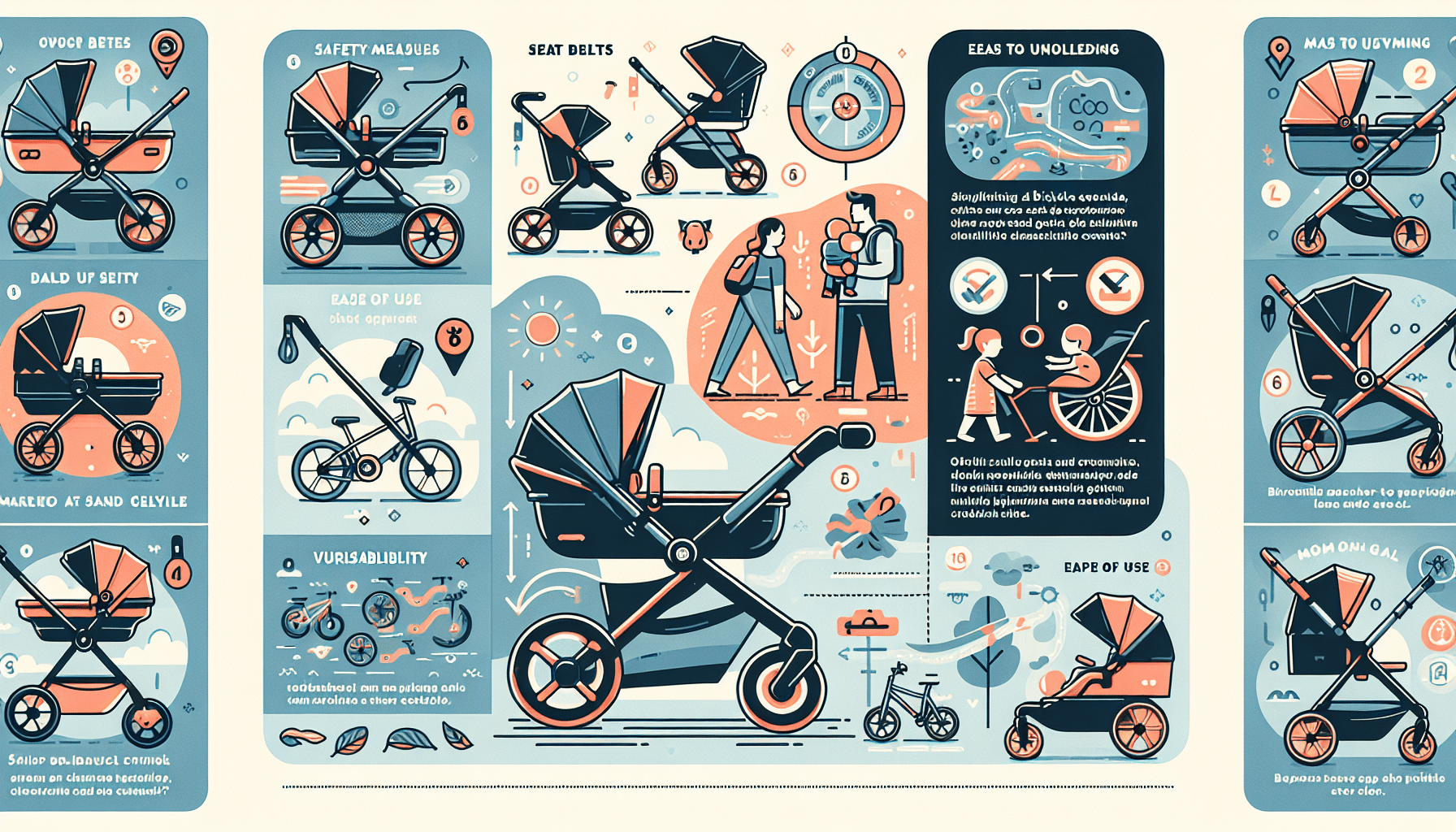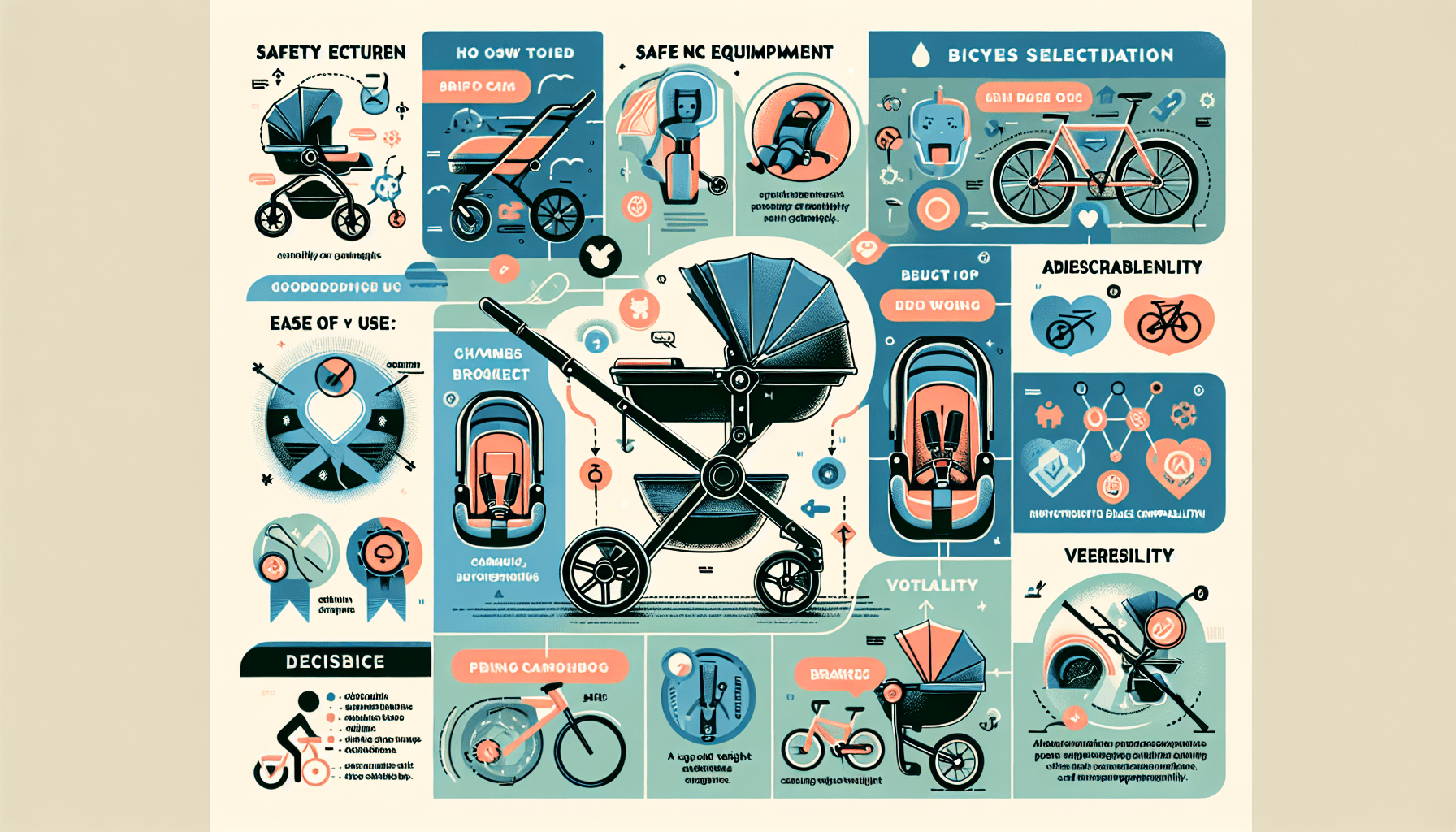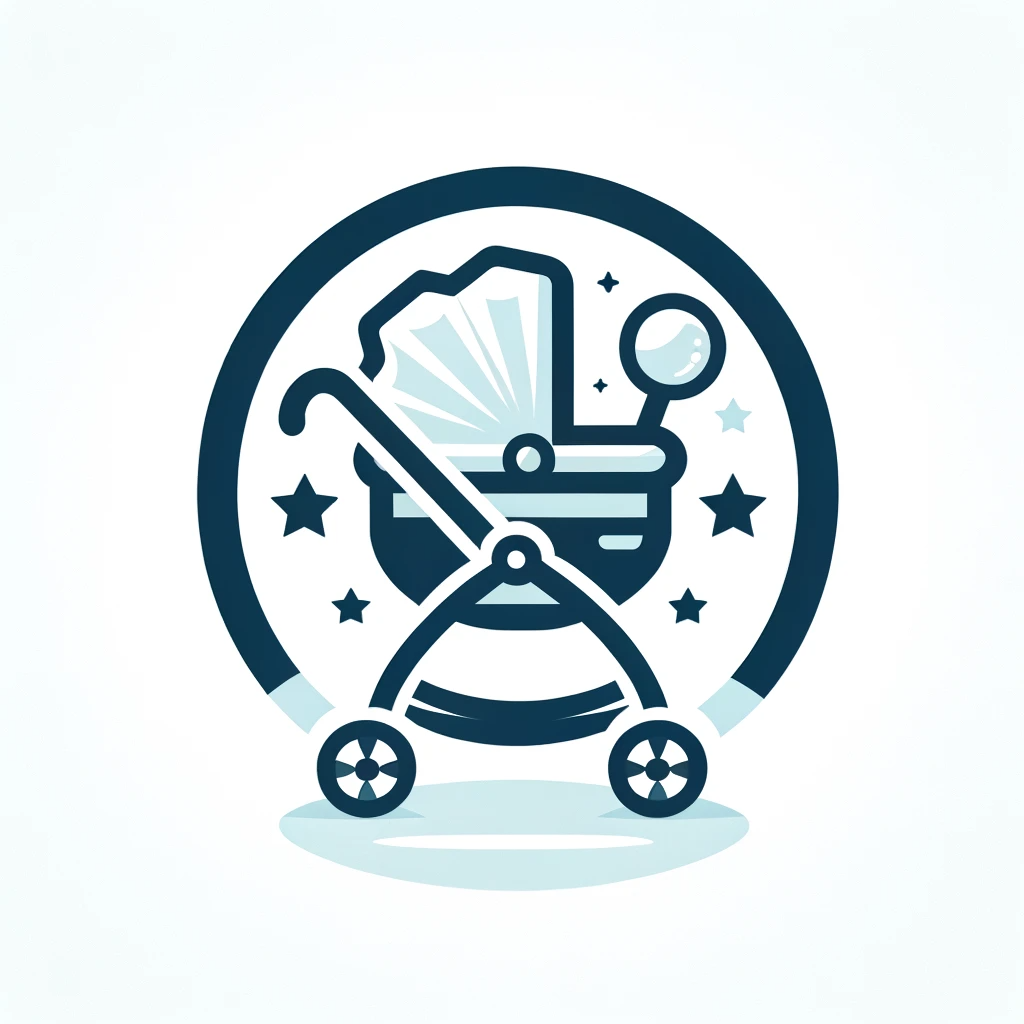Are you a parent on the lookout for a convenient and versatile stroller that can seamlessly transition from your daily walks to cycling adventures? Look no further! In this ultimate guide, we will help you navigate through the world of strollers with bicycle compatibility. We will explore the different features to consider, the benefits they offer, and provide valuable insight into choosing the perfect stroller to enhance your parent-child bonding experiences on and off the bike. Let’s embark on this exciting journey together!
The Ultimate Guide to Choosing a Stroller with Bicycle Compatibility
Are you an adventurous parent who loves to spend time outdoors with your little one? If so, a stroller with bicycle compatibility may be the perfect choice for you. With a wide range of options available, it can be overwhelming to choose the right one. That’s why we’ve put together this comprehensive guide to help you make an informed decision. From safety features to terrain types and price ranges, we’ll cover everything you need to know before purchasing a stroller with bicycle compatibility. So let’s dive in and explore the different types of strollers available!

1. Types of Strollers with Bicycle Compatibility
1.1. Bike Trailer/Stroller Combo
Bike trailer/stroller combos are versatile and convenient options for active parents. These strollers can be easily attached to the back of your bicycle, allowing you to tow your child along on your cycling adventures. When you’re not biking, they can quickly convert into traditional strollers, making them perfect for everyday use.
1.2. Jogging Stroller with Bike Attachment
If you’re an avid jogger, a jogging stroller with a bike attachment may be the ideal choice for you. These strollers are specifically designed for high-speed activities and provide enhanced stability. With the bike attachment, you can seamlessly switch between jogging and cycling, giving you the flexibility to enjoy different types of workouts with your little one.
1.3. Convertible Strollers
Convertible strollers are the jack-of-all-trades in the world of strollers with bicycle compatibility. These strollers can be used as traditional strollers, jogging strollers, and bike trailers. With their versatile design, they offer maximum flexibility to suit your changing needs and preferences.
2. Considerations Before Buying a Stroller with Bicycle Compatibility
Choosing the right stroller with bicycle compatibility involves considering several important factors. Let’s take a closer look at each one:
2.1. Safety Features
The safety of your child should be your top priority. Look for strollers with safety features such as a 5-point harness system, reflective materials for enhanced visibility, a handbrake system for quick stops, a suspension system to absorb shocks, a safety flag for increased visibility, and a parking brake to prevent unintended movement.
2.2. Weight and Size
Consider the weight and size of the stroller to ensure it’s suitable for your needs. While lightweight strollers are easy to maneuver and transport, they may not offer as much stability as heavier models. Additionally, consider the dimensions of the stroller when folded to ensure it fits in your vehicle or storage space.
2.3. Age and Weight Limitations
Check the age and weight limitations of the stroller to ensure it is suitable for your child’s age and size. Some strollers are designed for infants, while others are better suited for toddlers. It’s important to choose a stroller that accommodates your child’s growth and development.
2.4. Compatibility with Bicycle
Ensure that the stroller is compatible with your bicycle. Look for strollers with a hitch system that can easily attach to your bike. Additionally, consider the wheel size and type to ensure compatibility with your bicycle’s wheels.
2.5. Terrain Type
Think about the type of terrain you’ll be traversing with your stroller. If you primarily stick to smooth pavement, a stroller with smaller wheels may be sufficient. However, if you plan on tackling off-road trails or mountain biking paths, opt for a stroller with larger wheels and sturdy suspension for better stability and comfort.
2.6. Storage and Transportation
Consider the stroller’s foldability, storage space, and removable wheels. A stroller that folds compactly will be easier to store and transport. Additionally, ample storage space is essential for carrying your essentials while on the go. Removable wheels can further enhance convenience during storage or transportation.
2.7. Price Range
Finally, determine your budget and explore strollers within your price range. Strollers with bicycle compatibility come in a wide range of prices. While budget-friendly options may offer basic features, higher-end options often provide advanced safety features, superior comfort, and additional accessories.
3. Safety Features to Look for in a Stroller with Bicycle Compatibility
When it comes to strollers with bicycle compatibility, safety should be your utmost concern. Here are some key safety features to look for:
3.1. 5-Point Harness System
A 5-point harness system secures your child safely in the stroller, minimizing the risk of falls or injuries. This harness consists of straps over both shoulders, around the waist, and between the legs, ensuring your child is securely fastened at all times.
3.2. Reflective Materials
Strollers equipped with reflective materials increase visibility, especially during low-light conditions. Look for strollers with reflective strips or piping to enhance safety when cycling or jogging during dawn or dusk.
3.3. Handbrake System
A handbrake system allows you to quickly stop the stroller when needed. This feature provides added control and ensures your child’s safety during abrupt stops or downhill descents.
3.4. Suspension System
A suspension system helps absorb shocks and vibrations, ensuring a smooth ride for your little one. Look for strollers with adjustable suspension systems, allowing you to customize the level of suspension based on the terrain you’re traversing.
3.5. Safety Flag
A safety flag is a highly visible marker that attaches to the stroller, making it easily noticeable to other cyclists or joggers in your vicinity. This flag can significantly enhance safety by alerting others to the presence of your stroller.
3.6. Parking Brake
A parking brake is essential for preventing the stroller from rolling away when stationary. Ensure that the stroller you choose has a reliable parking brake to provide stability and security when you need to take a break.
4. Weight and Size Considerations for a Stroller with Bicycle Compatibility
Considering the weight and size of the stroller is crucial for both usability and convenience. Here are some key factors to keep in mind:
4.1. Maximum Weight Capacity
Check the stroller’s maximum weight capacity to ensure it can support your child’s weight comfortably. Consider your child’s current weight and potential growth to choose a stroller that can accommodate them for an extended period.
4.2. Folded Size
The stroller’s folded size is an important consideration, especially if you plan to transport or store it frequently. Measure your vehicle’s trunk or storage space to ensure the stroller fits without any issues. Additionally, opt for a stroller that folds compactly for hassle-free transportation.
4.3. Maneuverability
Consider the stroller’s maneuverability, especially if you’ll be navigating tight spaces or crowded areas. Lightweight and compact strollers are generally easier to maneuver, allowing you to navigate with ease.

5. Age and Weight Limitations for a Stroller with Bicycle Compatibility
To ensure the safety and comfort of your child, it’s essential to adhere to the recommended age and weight limitations of the stroller. Let’s explore these limitations in detail:
5.1. Infant Use
Some strollers with bicycle compatibility are suitable for infants from birth. These strollers typically feature a reclining seat and provide adequate head and neck support. However, it’s important to note that young infants may require additional support, such as infant inserts or car seat adapters.
5.2. Toddler Use
As your child grows, they’ll require a stroller that accommodates their increasing weight and size. Many strollers with bicycle compatibility have weight limitations of up to 50 pounds or more, making them suitable for toddlers up to the age of 4 or 5 years.
5.3. Weight Restrictions
Be aware of the stroller’s weight restrictions to ensure your child’s safety. Exceeding the recommended weight limit can compromise the stroller’s stability and may lead to accidents or damage.
6. Ensuring Compatibility with Your Bicycle
To enjoy a seamless strolling and cycling experience, ensure that the stroller is compatible with your bicycle. Consider the following factors:
6.1. Hitch System Compatibility
Check if the stroller’s hitch system is compatible with your bicycle. Different strollers may have different hitch systems, so it’s crucial to choose one that can be easily attached to your bike.
6.2. Wheel Size and Type
Consider the size and type of wheels on both the stroller and your bicycle. Matching the wheel sizes can ensure a smooth and stable ride. If the stroller’s wheels are not the same size as your bicycle’s wheels, it may affect the stroller’s stability and maneuverability.
6.3. Installation Process
Familiarize yourself with the installation process of the stroller to ensure a hassle-free experience. User-friendly installation mechanisms, such as quick-release systems or easy-to-follow instructions, can save you time and effort.
7. Choosing the Right Stroller for Different Terrain Types
Each terrain type presents unique challenges and requirements for strollers with bicycle compatibility. Consider the following:
7.1. Smooth Pavement
For daily walks or casual rides on smooth pavement, strollers with smaller wheels and less aggressive suspension systems are suitable. These strollers are lightweight and maneuverable, making them ideal for urban environments.
7.2. Gravel and Off-Road Trails
When venturing onto gravel or off-road trails, opt for strollers with larger, air-filled tires and robust suspension systems. These features provide better traction, stability, and shock absorption, ensuring a comfortable ride for your child.
7.3. Mountain Biking Trails
If you plan to tackle rugged mountain biking trails, choose a stroller specifically designed for this purpose. Look for strollers with heavy-duty frames, large knobby tires, advanced suspension systems, and robust safety features. These strollers are built to withstand the demands of rough terrains, ensuring optimal safety and comfort.
8. Convenient Storage and Transportation Features
Convenience is key when it comes to strollers with bicycle compatibility. Consider the following storage and transportation features:
8.1. Foldability
Opt for a stroller that can be easily folded and unfolded. This feature is especially essential for frequent travelers or individuals with limited storage space. A compactly folded stroller allows for hassle-free transport and storage.
8.2. Storage Space
Ample storage space is crucial when you’re on the go with your little one. Look for strollers with spacious storage baskets or additional pockets to accommodate your essentials, such as diapers, snacks, and water bottles.
8.3. Removable Wheels
Strollers with removable wheels offer added flexibility during storage or transportation. This feature enables you to disassemble the stroller into smaller components, making it more compact and easier to handle.
9. Price Range for Strollers with Bicycle Compatibility
When it comes to strollers with bicycle compatibility, price ranges vary depending on the features and quality. Consider the following options:
9.1. Budget-Friendly Options
Budget-friendly strollers are a great choice if you’re looking for basic functionality without breaking the bank. These strollers often offer essential safety features and decent durability, making them suitable for occasional use.
9.2. Mid-Range Options
Mid-range strollers offer a balance between affordability and additional features. These strollers may provide advanced safety features, improved suspension, and more comfortable seating options. They are suitable for regular use and cater to a wider range of needs.
9.3. High-End Options
High-end strollers feature superior build quality, advanced safety features, and enhanced comfort. They often come with additional accessories and customization options. If you’re a serious cyclist or runner looking for the best possible stroller experience, high-end options are worth considering.
10. Tips for Maintaining and Using a Stroller with Bicycle Compatibility
To ensure the longevity and optimal performance of your stroller with bicycle compatibility, consider the following maintenance and usage tips:
10.1. Regular Cleaning and Maintenance
Clean your stroller regularly to remove dirt, debris, and any spills. Check for wear and tear or loose parts, and address any issues promptly. Refer to the manufacturer’s instructions for specific cleaning guidelines and maintenance suggestions.
10.2. Proper Assembly and Attachment
Always follow the manufacturer’s instructions for proper assembly and attachment to your bicycle. Incorrect installation can compromise safety and stability. Take your time and ensure all components are securely fastened before using the stroller.
10.3. Safe Riding Practices
Adhere to safe riding practices, especially when using a stroller with bicycle compatibility. Maintain a safe distance from other cyclists or pedestrians, obey traffic rules, and always use your handbrakes when necessary. Additionally, wearing protective gear, such as helmets, is strongly recommended for both you and your child.
In conclusion, a stroller with bicycle compatibility can be a valuable investment for active parents who want to share their love for outdoor activities with their little ones. By considering factors such as safety features, weight and size, age limitations, compatibility with your bicycle, terrain type, storage and transportation features, price range, and proper maintenance and usage, you can confidently choose the right stroller that meets your specific needs. So gear up and embark on countless adventures with your child while enjoying the freedom and convenience of a stroller with bicycle compatibility. Happy strolling and cycling!


